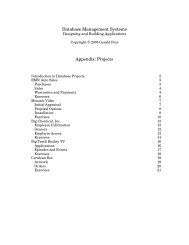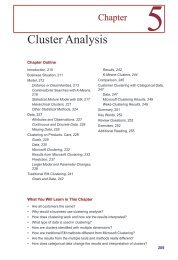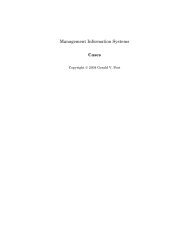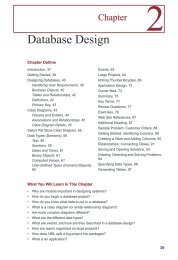Database Projects/5e - Professor Jerry Post
Database Projects/5e - Professor Jerry Post
Database Projects/5e - Professor Jerry Post
You also want an ePaper? Increase the reach of your titles
YUMPU automatically turns print PDFs into web optimized ePapers that Google loves.
Product<br />
Design Version<br />
Customer<br />
E-mail<br />
Machine Start Date/Time<br />
Operator End Date/Time<br />
Quantity Produced Defective Count<br />
Overall Quality<br />
Comments/Problems<br />
Project Descriptions<br />
Input Quantity Vendor Quality Comments<br />
Figure 3<br />
inputs. In these situations, a vendor might receive multiple orders. Most vendors<br />
simply add up the total amount needed for the similar items and make one shipment.<br />
When the shipment arrives, it is checked in against the multiple orders—so<br />
even though it is one shipment, it is treated as if multiple items were received. The<br />
shipping costs are then split among the multiple orders based on the percentage of<br />
product needed.<br />
Production<br />
Many production companies record detailed information about each production<br />
step, such as the time, the employees involved, the quantity produced, and quality<br />
control measures from the individual machines and the inputs. It is also helpful<br />
to record any problems that arise such as broken parts and power outages. For an<br />
initial design, it is easier to start with the basic production information. Figure 3<br />
tracks production by steps based on the individual machines. The figure shows<br />
basic data for one machine, but a production run can often use multiple machines.<br />
Note that a production can use a specific version of a product—which is not necessarily<br />
the latest version on file. Sometimes customers want to use earlier versions,<br />
so this version needs to be tracked. Each machine is run by an employee<br />
operator. The total quantity produced is recorded as well as the number of defective<br />
items that are discarded or recycled. An inspector records the overall quality<br />
and lists any specific comments or problems that were found.<br />
The firm also needs to track the amount of each input used at each step of production.<br />
These values are processed by engineers to refine the design estimates<br />
and to track the amount of wastage. When possible, the vendor of the input is<br />
recorded to see if some inputs are more efficient than others. Input quality control<br />
examines the input resources for obvious defects and records any problems in the<br />
comments section. More specific quality control measures and testing processes<br />
are conducted separately with that data recorded in a different system. For example,<br />
chemists perform tests on samples of the inputs to determine if they meet the<br />
desired standards. Because this process is handled outside of the normal production,<br />
the results are stored in a different system.<br />
45







